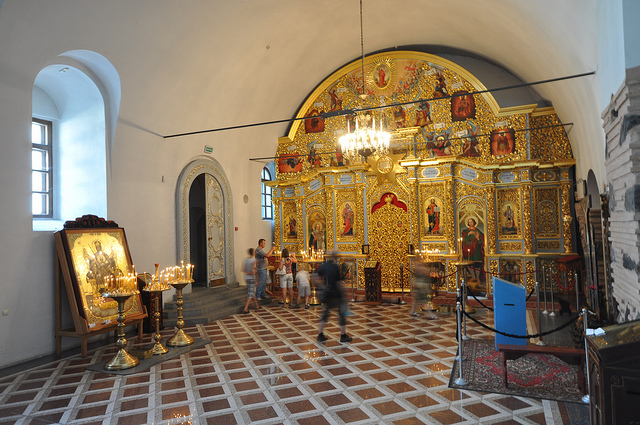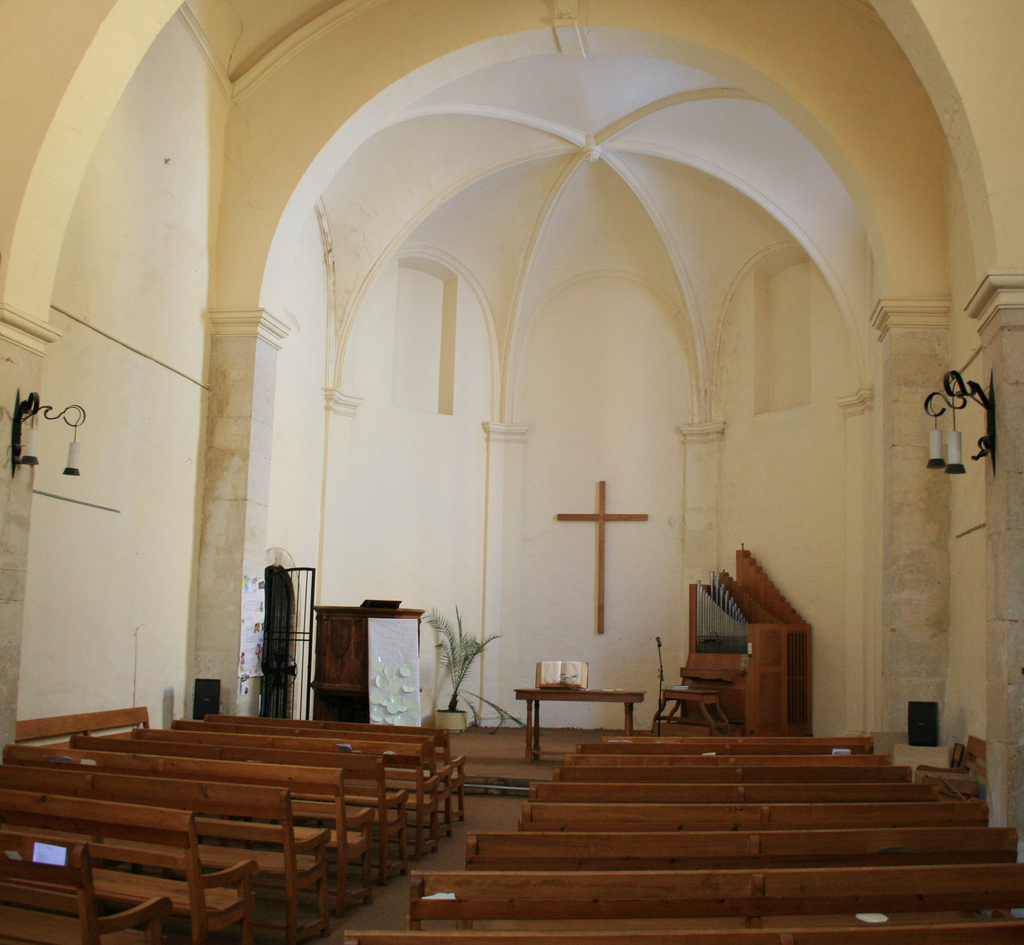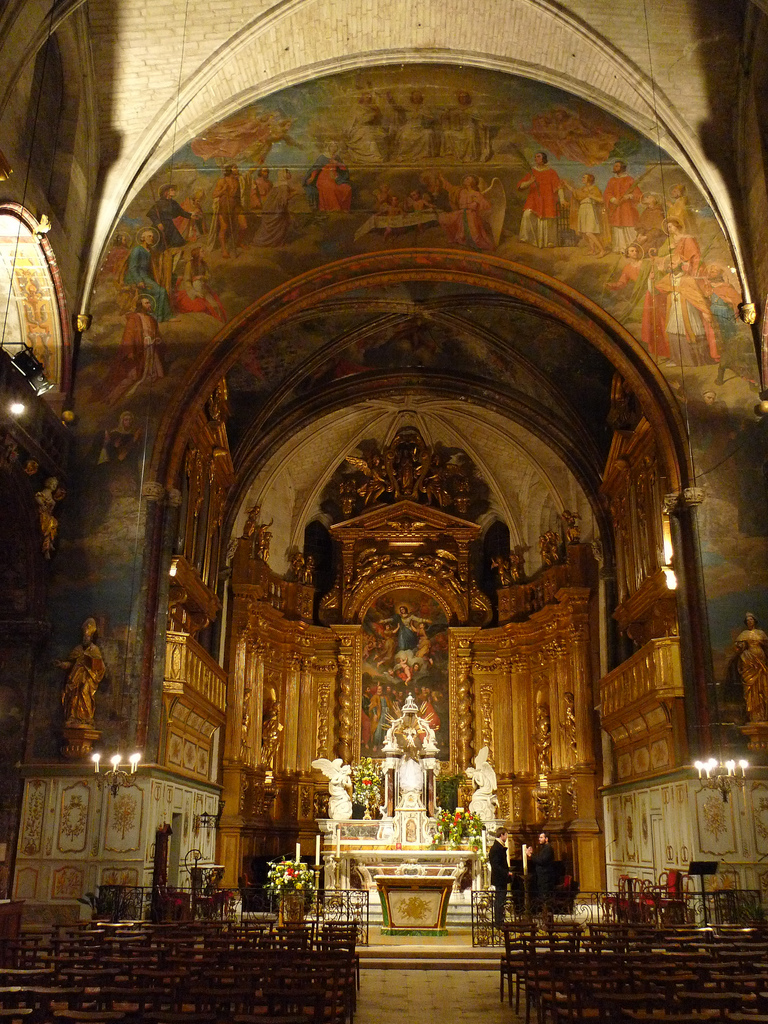Early Christians were given no sanction to hold worships by the Roman authorities; hence, they could not assemble in special venues for their activities (including religious), and they often worshiped in privates homes. Once Christianity was legalized under Constantine (in 313), Christians were allowed to have worship sites and build new ones. For reasons both practical (to accommodate growing congregations) and religious (the Christian space of worship was to be accessed by all, unlike the Jewish Temple in Jerusalem, or pagan temples), the design of a civic building was chosen, the basilica, which served as a public court in Roman cities and could receive large numbers. Featuring an apse at one end, this building allowed worshipers to congregate in its rectangular space (called nave), while the officiant performed from the apse (called chancel or sanctuary) where the altar was contained, being the communion table used in the Eucharist.
The Eucharist rite (eucharist means "thanksgiving") was regarded by all Christians, then as now, as having been ordained by Jesus at his final meal with his disciples, before his crucifixion. It commemorates the Last Supper and has been at the center of Christian liturgy from the earliest communities. The liturgy includes prayers as well: the Psalms (as with Jewish liturgy, expectedly, since the first Christians were Jews and they continued Jewish tradition), and the Lord's Prayer, which is a prayer specific to Christians and is attributed to Jesus (see Matthew 6:7-15).
The Christian place of worship of the early times was designed to fulfill three religious functions: to serve as the House of God; to provide a venue for the celebration of liturgy; and to be a place of teaching. However, it differed entirely from other worship sites by holding, in the same space, teachings (Scripture readings and commentaries) and liturgical celebrations. This was a radical departure from the traditional religious practice, whereby public worship took place outside the house of the divinity, which itself was rarely accessed and restricted to the very few. The Christian place of worship was the place where the community of worshipers assembled, hence its name in the Latin languages – "église" in French, "chiesa" in Italian, "iglesia" in Spanish – derived from the verbal noun in Greek, ekklesia (the verb meaning to call or summon), which referredto the citizens' assembly (male only) in Athenian public life. Hellenistic Judaism took over the Greek term in a religious sense to designate an assembly convened for religious purposes, and in that tradition, the Christians used it to designate the assembly of the “summoned”, i.e., those initiated by the rite of baptism. The church was the place where the baptized assembled for the liturgy. Hence, the baptismal font was originally located outside the church, in a nearby structure called the baptistery (see the baptistery of Fréjus, for example). In time, the baptistery was placed in an annex chapel, then inside the church near a lateral entrance. How this evolved over time depends on the locality. In Italy, until the 15th century, the baptistery was a separate edifice (see for example the octagonal Florence Baptistery, which stands on the Piazza Duomo). As adult baptism shifted to infant baptism, and became a rite where the baptized were no longer immersed, the basins diminished in size.
The church’s three main functions are common to all Christian places of worship. Yet depending on the time, place, and denomination, either one or the other was privileged, and resulting architectural designs were many.
The Latin or Catholic church
The Latin (later Catholic) church’s main purpose is to be the House of God and the place of celebration of the Eucharist. The dogma of transubstantiation (the doctrine of revelation which holds that the substances of bread and wine in the Eucharist become the body and blood of Christ), which was affirmed at the Lateran Council of 1215, augmented the divine nature of the Eucharist and of bread and wine, and the term host was used. The sanctity of the chancel (also called sanctuary), where the altar stands and the host is preserved, was thereby heightened. It was often separated from the nave by a jube (rood screen), an ornate partition of wood or stone, this until the Council of Trent in the 16th century condemned it. The Vatican Council (1962-1965) enabled the celebration of the Eucharist to be brought even closer to worshipers.
The church’s interiorwas conceived to enhance the sanctity of its space, although certain choices also provoked controversies over the need to display richness. One example is the controversy in the 12th century between Bernard of Clairvaux (who emphasized purity and influenced the design of Cistercian monasteries characterized by the absence of ornamentation) and Peter the Venerable (Abbot of Cluny, who emphasized light and color to give glory to God).
The Greek or Orthodox church
The Greek (later Orthodox) church presents similarities, particularly in respect to its rich surroundings for the sake of sanctity. Its centerpiece is the iconostasis, a tall partition of wood or stone layered with icons. The icons are not works of art, but objects representing the Lord (Jesus), the Mother of God (Mary), and the Saints, which are made in accordance with strict rules treating them both as a universal visual language and as a substitute for the prototypes they symbolize. Icons are objects, not of adoration (as with idols), but of proskynesis, a proper level of veneration, whereby worshipers pray to them by performing two gestures – bowing from the waist and kissing the icon. Icons have a central role in the "Divine Liturgy" (the Orthodox equivalent of "Mass" in the Catholic world) – intercession (i.e., mediation by the prototypes with God), and teaching about the faith. The iconostasis separates the nave from the chancel, thereby hiding, still today, the celebration of the Eucharist from the congregation. The iconostasis typically has three doors through which ecclesiastics pass, as they move from the nave to the chancel: the central Holy Door used by priests, and a door on either side, used by deacons and others.
The Protestant church
Compared with the other places of worship, the Protestant church (called “temple” by early Calvinists in reaction against the Catholic model) presents a marked contrast, although in Europe, several Protestant places of worship used to be Catholic churches. Its interior setting is plainer, at times virtually bare. Its centerpiece is the pulpit, where the preacher stands to address the congregation and read the “scripture lessons”. The pulpit is often located in a central position, sometimes raised so that all worshipers may hear the preaching. The overriding purpose of the Calvinist temple or the Lutheran church is to teach.
Finally, “megachurches” should be mentioned, giant churches that are the modern manifestation of a long Protestant tradition, and who bear witness to an Evangelical revival in the United States. As early as the 18th century, Protestants have gathered in large open-air congregations, especially in the North American colonies. The megachurches of today can hold attendants [in the several thousand], and many offer a variety of extra-worship services, thereby fostering community life.









